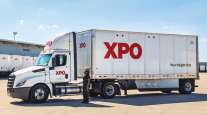Staff Reporter
XPO Reports $1.9 Billion Revenue for Q1

[Stay on top of transportation news: Get TTNews in your inbox.]
XPO Inc. experienced an increase in revenue despite a challenging freight environment during the first quarter of 2023, the company reported May 4.
The Greenwich, Conn.-based less-than-truckload carrier posted net income attributable to the company of $14 million, or 13 cents a diluted share, for the three months ending March 31. That compared with $488 million, $4.22, during the same time the previous year. Total revenue increased by 1.1% to $1.91 billion from $1.89 billion.
XPO ranks No. 3 on the Transport Topics Top 100 list of the largest for-hire carriers in North America.
"Now with a pure-play LTL provider here in North America, the entire team is focused on executing on our LTL 2.0 plan and our long-term strategy is working,” CEO Mario Harik told Transport Topics. “Now, obviously, the macro is soft, and we see that as a challenging environment. But our strategies are enabling us to effectively drive those types of results.”
Harik pointed to shipments per day as an example of where the business strategy has seen results. The earnings report noted that shipments per day increased 1.5% on a year-over-year basis to 49,107 from 48,366. It also showed tonnage per day decreased 1.8% and yield increased 1.4%. XPO views yield as one of the main levers to accelerate growth.
“We are taking profitable market share,” Harik said. “Our Q1 service quality is the best in a decade. We’re taking care of our customers, and we’re earning a bigger market share from their business and we’re also earning pricing that we expect to accelerate over time as well given the improvements in the service product.”
Today, we released solid financial results for Q1 2023, with some of our highest service quality levels in over a decade. Read more here: https://t.co/nWtuHHfv8M pic.twitter.com/h1zDkYIQog — XPO (@XPOLogistics) May 4, 2023
XPO over the past couple of years has undergone a process of becoming a pure-play LTL provider by spinning off certain business operations into stand-alone companies. The net income included continuing and discontinued operations. Adjusted net income from continuing operations attributable to common shareholders increased to $65 million, or 56 cents an adjusted diluted share, from $53 million, 46 cents, during the year-ago period.
“Now that we are a pure play less-than-truckload provider, we are deploying more capital into the business,” Harik said. “That’s enabling us to get more trucks, more trailers and more doors from a network perspective, and we’re going to invest through the cycle as well.”
The LTL 2.0 strategy essentially aims to build upon the core LTL foundation that was created. Its four main focuses are improving customer service, network investments, yield growth and cost efficiencies. XPO has also been working to attract LTL leaders to execute on its strategies.

This special "Inside the List" episode features the Transport Topics 2023 Top 100 largest logistics companies. Hear the program above and at RoadSigns.TTNews.com.
“All of these parts of the strategy are playing out very nice,” Harik said. “We are attracting the best talent in the industry. I mean, we have two fantastic LTL veterans who have joined our team here. J. Wes Frye, who’s an LTL legend, joined our board in the first quarter and we hired Dave Bates, who I believe is one of the best operators in the entire LTL industry, to be our chief operating officer. And he just joined our team here a couple of weeks ago. So, there’s a lot of momentum.”
The results were mixed in terms of expectations by investment analysts, which had been looking for 45 cents per share and quarterly revenue of $1.86 billion, according to Zacks Consensus Estimate. But when considering continuing operations, both adjusted metrics beat expectations.
Want more news? Listen to today's daily briefing above or go here for more info
“If you do a like-for-like, our revenue has grown from Q1 of last year to Q1 of this year, despite the soft market, our adjusted EPS has grown 22% year-on-year,” Harik said. “Our adjusted EBITDA has grown by 14% year-on-year, exceeding our guidance for the first quarter as well. So, when you look at those comparisons, it’s important obviously to look at it as continuing operations in Q1 of last year and continuing operations in Q1 of this year.”
North American less-than-truckload revenue increased 0.9% to $1.12 billion from $1.11 billion a year ago. Shipments per day year-over-year increased 1.5%, while tonnage per day decreased 1.8%. Operating income decreased 8% to $103 million from $112 million last year.
“The impact of the economy was evident throughout the quarter as demand for LTL stayed below historical levels, driving a 3.3% decline in our weight per shipment,” Chief Strategy Officer Ali Faghri said during a call with investors. “We partially offset this with a 1.5% increase in shipment count, led by 9% growth in our local channel. This is a direct reflection of service improvements in the network. As a result, we were able to limit the decline in tonnage per day to 1.8%.”
European transportation revenue was virtually unchanged year-over-year at $787 million. The segment generated an operating loss of $3 million compared with operating income of $1 million last year. The first-quarter loss reflected $7 million in restructuring expenses related to cost reduction actions.




